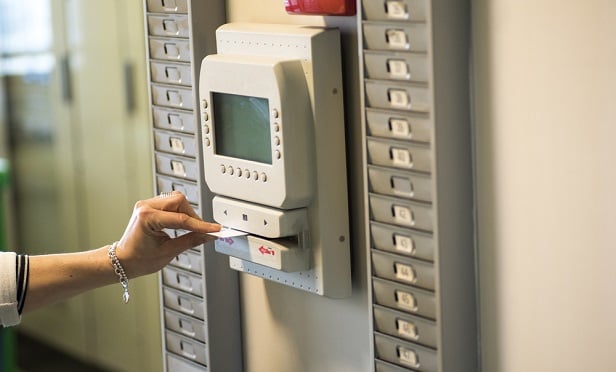 The old-fashionedtime clock system that requires punching in and out with a papercard is by no means high tech, but it is affordable and stillavailable today. (Photo: Shutterstock)
The old-fashionedtime clock system that requires punching in and out with a papercard is by no means high tech, but it is affordable and stillavailable today. (Photo: Shutterstock)
Under the federal Fair Labor Standards Act (FLSA), all employerswith sales of $500,000 a year or more are required to keep recordsof the time all their employees work. Failure to do so can resultin significant penalties. Regulations aside, accurately tracking worker time and attendance isobviously in the best interests of your business.
|However, tracking and recording employee time can be more of achallenge than you might expect, with overtime rules, labor laws related to clockingin and out, and all the different time tracking options availabletoday. Here we have compiled some tips to help you simplify theprocess of tracking your employees' time.
|Overtime rules
When overtime is not carefully managed, it can increase yourlabor costs significantly. Under federal law, all hourly employeeswho work more than 40 hours per week are entitled to one and a halftimes their regular pay rate for the overtime hours they work.
|Related: Joint employment, overtime and other wage-and-hourissues to watch
|It may be necessary to incur overtime expenses to meet yourproduction demands. However, it is vital to have accurate overtimerecords to help you stay on top of costs and to protect yourcompany in case an employee claims to be owed overtimecompensation. To stay on solid ground, you need to have detailed,accurate overtime records that are easily accessible.
|Time clock rules
In administering FLSA, the U.S. Department of Labor (DOL) doesnot require any particular form of recordkeeping, and time clocksare not required. For all employees subject to minimum wage orminimum wage and overtime provisions, employers must keep a recordof:
- Employee name, home address, occupation, sex, and birth date ifunder 19 years of age
- Day and hour when workweek begins
- Total hours worked each workday and each workweek
- Regular hourly pay rate for any week in which overtime isworked
- Total daily or weekly straight time earnings
- Total overtime pay for each workweek
- Total wages for each pay period
- Deductions from or additions to wages
- Pay period covered and date of payment
Finding the best system for keeping track of employee hours andovertime may require some careful consideration. Factors toconsider may include the size of your workforce, your comfort levelwith technology, and how carefully you need to monitor youremployees. The following are some clocking in and out optionsavailable today.
|Punch-clock system
The old-fashioned time clock system that requires punching inand out with a paper card is by no means high tech, but it isaffordable and still available today. However, more advancedsystems that use computing to organize your data and generatereports are likely to be more cost-effective in the long run.
|Proximity clocking
This type of system uses “proxy cards” assigned specifically toindividual employees. Each of these cards contains a radiofrequencyidentification (RFID) chip, a capacitator, and an antenna. The cardis placed near a scanner linked to a clock to record the employee'sarrival time. RFID cards can also be used to restrict access tocertain areas, depending on the level of security your companyrequires. The downside is that, unlike fingerprints, RFID cards canbe lost or stolen.
|Biometric clocking
Buddy punching (one employee clocking in for another) can be areal issue affecting production and costs. Biometric clocking completely resolves thisissue. It uses facial recognition or fingerprints to verifyidentity and clock employees in.
|PC clocking
A desktop or laptop can be used as a tool for clocking in andout. This can be set up in a couple of different ways:
|Scanning device: A device can be connected tothe computer that reads a card, key fob, or fingerprint. This typeof system is typically best for in-office use, but the devices canbe costly.
|Cloud-based system: Employees can check in andout on a web-based interface, preferably as part of an integratedpayroll and workforce management system.
|Mobile phone clocking
If you have employees who work remotely or have appointments outof the office or out of town, mobile phone tracking may be anexcellent option for your company. Employees simply clock in via anapp on their cell phones. Mobile managers may want to use asupervisor mode to clock employees in and out. These systems can beoptimized with geo-fencing and facial biometric punches to helpensure that the correct employees are clocking in on site.
|Monitoring your time-tracking system
Once you decide on the best type of system for your employees toclock in and out, the next thing is to ensure the system is beingused daily and continuously monitored for errors. It is vital tohave someone responsible for overseeing your data archives, whetherit consists of a pile of timecards, spreadsheets, or a cloud-baseddatabase. Employee time records must remain secure and preferablybacked up, to protect your company under federal regulations andlabor laws.
Read more:
- 5 wage and hour compliance issues that could costemployers
- Gig work, data privacy and other workplace trendsto watch
- The 2017 see-saw overtimerules
 Michelle Lanter Smith isthe chief marketing officer of EPAY Systems,where she oversees the company's go-to-market strategy, customersuccess and technical support operations. Michelle brings 20-plusyears of leadership experience in driving revenue growth for hightech and service-driven firms.
Michelle Lanter Smith isthe chief marketing officer of EPAY Systems,where she oversees the company's go-to-market strategy, customersuccess and technical support operations. Michelle brings 20-plusyears of leadership experience in driving revenue growth for hightech and service-driven firms.
Complete your profile to continue reading and get FREE access to BenefitsPRO, part of your ALM digital membership.
Your access to unlimited BenefitsPRO content isn’t changing.
Once you are an ALM digital member, you’ll receive:
- Critical BenefitsPRO information including cutting edge post-reform success strategies, access to educational webcasts and videos, resources from industry leaders, and informative Newsletters.
- Exclusive discounts on ALM, BenefitsPRO magazine and BenefitsPRO.com events
- Access to other award-winning ALM websites including ThinkAdvisor.com and Law.com
Already have an account? Sign In
© 2024 ALM Global, LLC, All Rights Reserved. Request academic re-use from www.copyright.com. All other uses, submit a request to [email protected]. For more information visit Asset & Logo Licensing.








